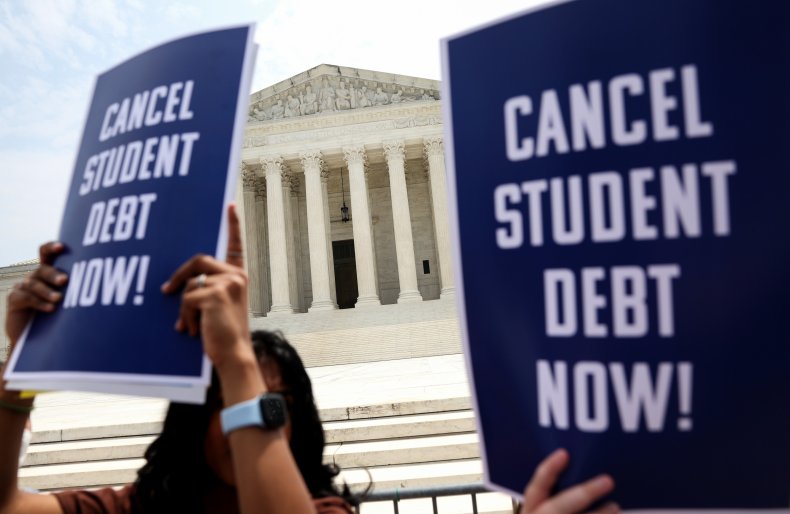The resumption of student loan payments after a three-year break, set for October 1, is likely to deliver a blow to American economic growth, according to economists, in a move that could harm many beyond borrowers alone.
Student loan payments were first paused by then-President Donald Trump in March 2020 as a relief measure for borrowers who were financially struggling during the pandemic. The break on payments was then extended nine consecutive times, lasting a total of three years—until now.
Interest started accruing back on September 1, while millions of borrowers will be asked to resume payments on their loans from next month. A total of 43 million Americans are estimated to hold a combined $1.75 trillion in student debt.
One in five student loan borrowers have risk factors that suggest they could struggle when scheduled payments resume, according to recent findings by the Consumer Financial Protection Bureau (CFPB).
STEFANI REYNOLDS/AFP via Getty Images
The Biden administration had fought to forgive millions in student loan debts for thousands of Americans, but the plan was struck down by the Supreme Court this summer.
“After three years of successful student loan forbearance we know one thing is true—people stopped paying their student loans and the sky didn’t fall,” Angela Hanks, chief of Programs at Demos and former Biden administration official, told Newsweek in a written statement.
“The forbearance also helped ensure that people did not face financial ruin as a part of a pandemic they did not cause, and borrowers found themselves on more solid financial footing, for many, for the first time in years,” she said.
“This meant that people were able to pay other bills on time, including basics like rent and groceries. For the millions of borrowers who will be forced into repayment in just a few weeks, this transition will undermine whatever stability they’ve been able to create for their families over the last few years.”
But the return of student loan payments could have direct consequences on the wider U.S. economy, economists agree.
“The end of the student loan forbearance risks disrupting an otherwise growing economy,” said Hanks. “Wages are outpacing inflation, and unemployment is down, but saddling families with another expensive bill risks undermining our collective economic progress.”
“The U.S. economy has proved incredibly resilient in recent quarters in the face of aggressive monetary tightening by the Federal Reserve, but potentially faces several big additional headwinds this fall: a federal government shutdown, the UAW strike and the resumption of student loan payments,” Jesse Wheeler, senior economist at decision intelligence company Morning Consult, told Newsweek.
“Morning Consult data shows that younger Americans have been critical in driving the high levels of consumer spending seen over the summer,” he added. “However, with 26 percent of millennials and 30 percent of Gen Z adults reporting student loan debt balances in August, the resumption of payments is poised to siphon billions of dollars out of the pockets of those who have recently shown the highest propensity to spend.”

Kevin Dietsch/Getty Images
According to Mark Zandi, chief economist of Moody’s Analytics, the end of the student loan payment moratorium in October will reduce annualized real GDP growth in the fourth quarter by an estimated 0.2 percent.
“Some 21 million borrowers will need to resume their payments, with the average payment of about $300 per month,” Zandi told Newsweek.
“This amounts to an increase of close to $75 billion in payments annually or 0.3 percent of GDP,” he continued. “But several million of these borrowers will not resume payments as they can’t or won’t because they will not be reported to the credit bureaus.”
On top of that, “several million borrowers will be put into income repayment plans that will lower their monthly payments,” Zandi added. “And of course, many other borrowers have other income and resources and will not cut back their spending because they are now paying on their student loans.”
Taking all of this into consideration, the impact of resuming student loan payments on consumer spending and the U.S. economy “will be meaningful, but small, approximately 0.2 percent of GDP.”
Credit: Source link




